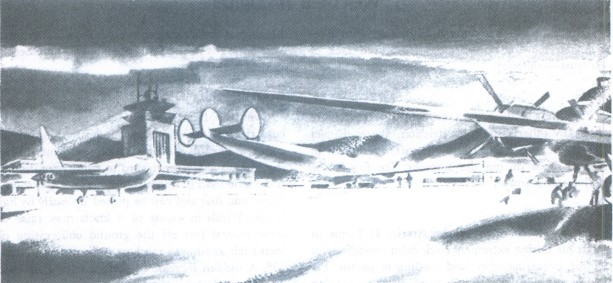Aviation Weather
full text of the classic FAA guide
WEATHER HAZARDS
Weather hazards include visibility restricting phenomena, blowing snow, icing, frost, and lack of contrast—whiteout.
FOG
Fog limits landing and takeoff in the Arctic more than any other visibility restriction. Water-droplet fog is the main hazard to aircraft operations in coastal areas during the summer. Ice fog is the major restriction in winter.
Ice Fog
Ice fog is common in the Arctic. It forms in moist air during extremely cold, calm conditions in winter, occurring often and tending to persist. Effective visibility is reduced much more in ice fog when one is looking toward the sun. Ice fog may be produced both naturally and artificially. Ice fog affecting aviation operations most frequently is produced by the combustion of aircraft fuel in cold air. When the wind is very light and the temperature is about −30° F or colder, ice fog often forms instantaneously in the exhaust gases of automobiles and aircraft. It lasts from as little as a few minutes to days.
Steam Fog
Steam fog, often called “sea smoke,” forms in winter when cold, dry air passes from land areas over comparatively warm ocean waters. Moisture evaporates rapidly from the water surface; but since the cold air can hold only a small amount of water vapor, condensation takes place just above the surface of the water and appears as “steam” rising from the ocean. This fog is composed entirely of water droplets that often freeze quickly and fall back into the water as ice particles. Low level turbulence can occur and icing can become hazardous.
Advection Fog
Advection fog, which may be composed either of water droplets or of ice crystals, is most common in winter and is often persistent. Advection fog forms along coastal areas when comparatively warm, moist, oceanic air moves over cold land. If the land areas are hilly or mountainous, lifting of the air results in a combination of low stratus and fog. The stratus and fog quickly diminish inland. Lee sides of islands and mountains usually are free of advection fog because of drying due to compressional heating as the air descends downslope. Icing in advection fog is in the form of rime and may become quite severe.
BLOWING SNOW
Over the frozen Arctic Ocean and along the coastal areas, blowing snow and strong winds are common hazards during autumn and winter. Blowing snow is a greater hazard to flying operations in the Arctic than in midlatitudes because the snow is “dry” and fine and can be picked up easily by light winds. Winds in excess of 8 knots may raise the snow several feet off the ground obliterating objects such as runway markers as illustrated in figure 135. A sudden increase in surface wind may cause an unlimited visibility to drop to near zero in a few minutes. This sudden loss of visibility occurs frequently without warning in the Arctic. Stronger winds sometimes lift blowing snow to heights above 1,000 feet and produce drifts over 30 feet deep.

ICING
Icing is most likely in spring and fall, but is also encountered in winter. During spring and fall, icing may extend to upper levels along frontal zones. While icing is mostly a problem over water and coastal areas, it does exist inland. It occurs typically as rime, but a combination of clear and rime is not unusual in coastal mountains.
FROST
In coastal areas during spring, fall, and winter, heavy frost and rime may form on aircraft parked outside, especially when fog or ice fog is present. This frost should be removed; it reduces lift and is especially hazardous if surrounding terrain requires a rapid rate of climb.
WHITEOUT
“Whiteout” is a visibility restricting phenomenon that occurs in the Arctic when a layer of cloudiness of uniform thickness overlies a snow or ice-covered surface. Parallel rays of the sun are broken up and diffused when passing through the cloud layer so that they strike the snow surface from many angles. The diffused light then reflects back and forth countless times between the snow and the cloud eliminating all shadows. The result is a loss of depth perception. Buildings, people, and darkcolored objects appear to float in the air, and the horizon disappears. Low level flight over icecapterrain or landing on snow surfaces becomes dangerous. Disastrous accidents have occurred as a result of whiteouts.
Table of Contents
Previous Section: Arctic Peculiarities
Next Section: Arctic Flying Weather
A PDF version of this book is available here. You may be able to buy a printed copy of the book from amazon.com.
